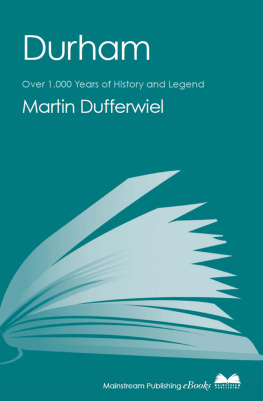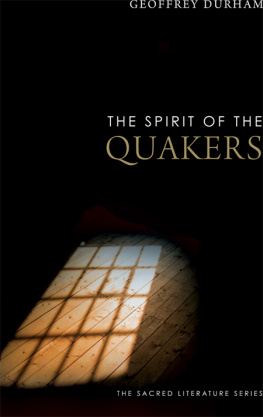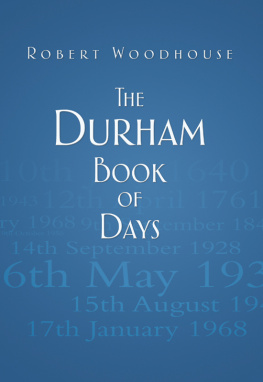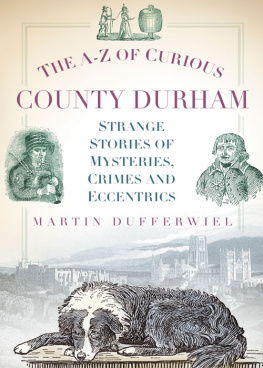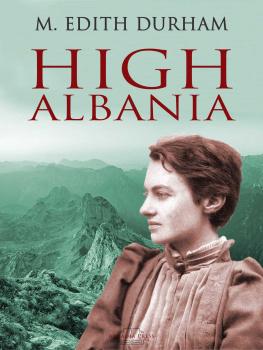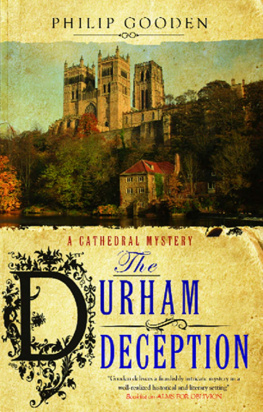Contents
DURHAM
Over 1,000 Years of History and Legend
Martin Dufferwiel
This eBook is copyright material and must not be copied, reproduced, transferred, distributed, leased, licenced or publicly performed or used in any way except as specifically permitted in writing by the publishers, as allowed under the terms and conditions under which it was purchased or as strictly permitted by applicable copyright law. Any unauthorised distribution or use of this text may be a direct infringement of the authors and publishers rights and those responsible may be liable in law accordingly.
Epub ISBN: 9781780573946
Version 1.0
www.mainstreampublishing.com
This edition, 2004
Copyright Martin Dufferwiel, 1996
All rights reserved
The moral right of the author has been asserted
First published in Great Britain in 1996 by
MAINSTREAM PUBLISHING COMPANY (EDINBURGH) LTD
7 Albany Street
Edinburgh EH1 3UG
ISBN 1 84018 914 2
No part of this book may be reproduced or transmitted in any form or by any means without written permission from the publisher, except by a reviewer who wishes to quote brief passages in connection with a review written for insertion in a newspaper, magazine or broadcast
A catalogue record for this book is available from the British Library
For Faye and Charlotte
Acknowledgments
Firstly, I thank my wife Lynn, without whose support, encouragement and patience, I would never have written this book. Special thanks go to Mary Sampson and Alan Pearce for their invaluable assistance in providing me with material. Thanks also go to Father Gordon Ryan, to Wendy Brown and to the staff of Durham City Library, in particular to Jean Gartland, for her help, and her misfortune at always seeming to be on duty when I requested old and invariably large and heavy volumes from the archives.
Finally to the memory of my late friend Tony Swainston, whose constant encouragement and gentle criticism were always an inspiration.
The diary extracts of Charles Mason and Jeremiah Dixon and quotations taken from the Philosophical Transactions are reproduced by kind permission of the President and Council of the Royal Society.
Authors Note
It is to state the glaringly obvious to say that history is about recorded fact. About names and dates, about what happened, where and when. In order to sketch for us an accurate picture of people and events from the past, historians spend their professional lives attempting to identify the truth concealed in the tradition, to separate the fact from the fable.
But surely history is much more than facts alone. Surely the complete picture of a peoples, a cultures, or indeed a regions history is one in which the bare framework of recorded fact has been fleshed out and made to come alive by the truths, half-truths and legends added to it by successive generations.
This book tells of people and events from a thousand years of history in Durham, both City and County. It is a book about history, but it is not, nor is it meant to be, a definitive historical work. That I leave to those who are qualified. Some of the subjects in the book are based firmly in fact, some are purely legendary, and others contain elements of both the truth and the tale, where the dividing line between recorded history and popular tradition has, through the passage of time, inevitably been dimmed and obscured.
So, as film director John Ford once said, When the legend becomes fact, print the legend.
Martin Dufferwiel
Introduction
For the purposes of this book, our history starts in the so-called Dark Ages of Anglo-Saxon England, and the arrival in Durham, in the year 995, of the community of St Cuthbert.
That is not of course to say that the history of Durham began at that time. Remains of cultures considerably pre-dating the Anglo-Saxons can still be seen in the region today. The Romans left their mark in the area. After conquering the native Brigantes, they quickly began to build. The settlement of Concangium at Chester-le-Street, the forts of Piercebridge, of Vinovia at Binchester near Bishop Auckland, of Longovicium at Lanchester and of Vindomora at Elchester were all at one time linked by the Roman highway of Dere Street, the supply route from York in the south to Hadrians Wall and the border forts in the north. Much older still are the Iron and Bronze Age remains which are scattered around the country and are even to be seen in and around Durham City, with Maiden Castle a notable example.
But our story starts with the Anglo-Saxons, and the establishment of the ancient kingdom of Northumbria. The northern marches of seventh-century England were hosts to never-ending battles between pagan warlords and Christian kings, supported by missionaries from Ireland and Iona. Oswald was a Christian Prince of Northumbria, a vast kingdom which at the time extended from the Vale of York to the Scottish Borders. He had spent some time in exile with the Celtic monks of Iona, but in the year 634, after an invasion of his homeland by the pagan Welsh, Oswald returned and at the head of an army defeated and killed the Welsh King, Cadwallon of Gwynedd, at the Battle of Heavenfield near Hexham in Northumberland. With his victory Oswald claimed his rightful kingship of Northumbria and, moreover, as King of Northumbria he became Bretwalda, the High King or Overlord of the many other kings in the England of his day.
Oswald moved quickly to spread the Christian faith throughout his realm as, although he was Christian, much of his kingdom remained pagan. He sent to Iona for monks to come and convert his subjects. The first mission to arrive in Northumbria soon returned to Iona, describing the native Northumbrians as wild and ungovernable men of harsh and barbarous disposition. The man that followed was called Aidan, a monk who would be described by Bede in his Ecclesiastical History of the English People as being of singular meekness, piety and moderation, zealous in the cause of God. In the Celtic tradition of St Columba and Iona, Aidan founded a monastic site in a separate place, near a chief City; it was he who began the Celtic Christian mission on the Holy Island of Lindisfarne, within sight of the Kings Royal Hall at Bamburgh.
A spiritual leader and teacher, Aidan began to expand his mission, out from the Thousand Acre Isle and across the wild lands of Northumbria. Preaching in Gaelic and having others, including King Oswald, interpret for him he showed, as Bede tells us, the authority befitting a Bishop in rebuking the proud and mighty, and was merciful in bringing comfort to the weak and relief and protection to the poor. It was Aidan who was to become the spiritual inspiration for a young boy from the Border hills by the name of Cuthbert, the boy who would one day himself become Bishop of Lindisfarne, be acclaimed a living saint, eventually come to be regarded as the patron saint of Northumbria, and whose body rests today in Durham Cathedral. It is with the tale of St Cuthbert that our book begins.
Chapter One
Beginnings
Deliver us O Lord from the fury of the Norsemen.
A prayer familiar no doubt to early Christian monks after the first Viking raids had been visited upon their monasteries, along the north-east coast of eighth-century England. The initial bloody and destructive raids made by the Vikings, the hateful plague of Europe as a contemporary scribe called the Norwegian and Danish raiders, were essentially piratical, made solely for plunder. Along the north-east coast of England, undefended coastal monastic settlements situated on sites chosen specifically for their isolation provided rich and easy pickings for the seaborne Norsemen. Once the Vikings had tasted the wealth that was to be gained from such raids, things in England were destined never to be the same again. From the late eighth century to the early eleventh, sporadic attacks continued. However, as the years passed, the small bands of armed raiders would become large, well-trained armies and rogue Norse longships would become full-scale invasion fleets bent on conquest, settlement and tribute.

